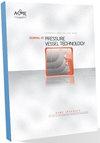Capturing the Temperature Dependence of Cleavage Fracture Toughness in the Ductile-to-Brittle Transition Regime in Ferritic Steels Using an Improved Engineering Local Approach
IF 1.4
4区 工程技术
Q4 ENGINEERING, MECHANICAL
Journal of Pressure Vessel Technology-Transactions of the Asme
Pub Date : 2022-05-09
DOI:10.1115/1.4054497
引用次数: 0
Abstract
Ferritic steels, which are typically used for critical reactor components, including reactor pressure vessels (RPV), exhibit a temperature-dependent probability of cleavage fracture, termed ductile-to-brittle transition. The fracture process has been linked to the interaction between matrix plasticity and second-phase particles. Under high-enough loads, a competition exists between cleavage and ductile fracture, which results from particles rupturing to form microcracks or particles decohering to form microvoids, respectively. Currently, there is no sufficiently adequate model that can predict accurately the reduced probability of cleavage with increasing temperature and the associated increase of plastic deformation. In this work, failure probability has been estimated using a local approach to cleavage fracture incorporating the statistics of microcracks. It is shown that changes in the deformation material properties are not enough to capture the significant changes in fracture toughness. Instead, a correction to the fraction of particles converted to eligible for cleavage microcracks, with an exponential dependence on the plastic strains, is proposed. The proposed method is compared with previous corrections that incorporate the plastic strains, and its advantages are demonstrated. The method is developed for the RPV steel 22NiMoCr37 and using experimental data for a standard compact tension C(T) specimen. The proposed approach offers more accurate calculations of cleavage fracture toughness in the ductile-to-brittle transition regime using only a decoupled model, which is attractive for engineering practice.利用改进的工程局部方法捕捉铁素体钢韧脆转变过程中解理断裂韧性的温度依赖性
铁素体钢通常用于包括反应堆压力容器(RPV)在内的关键反应堆部件,其解理断裂的概率与温度有关,称为韧脆转变。断裂过程与基体塑性与第二相颗粒的相互作用有关。在足够高的载荷下,解理断裂和韧性断裂之间存在竞争,分别是由于颗粒破裂形成微裂纹或颗粒退聚形成微孔洞。目前,还没有足够充分的模型能够准确预测解理随温度升高而降低的概率以及相应的塑性变形的增加。在这项工作中,利用结合微裂纹统计的局部解理断裂方法估计了失效概率。结果表明,变形材料性能的变化不足以反映断裂韧性的显著变化。相反,修正颗粒的比例转换为符合解理微裂纹,与指数依赖于塑性应变,被提出。将所提出的修正方法与以往包含塑性应变的修正方法进行了比较,证明了其优点。以RPV钢22NiMoCr37为研究对象,采用标准压实拉伸试样的实验数据,建立了该方法。该方法仅使用解耦模型就能更精确地计算出韧-脆转变状态下的解理断裂韧性,具有较好的工程应用价值。
本文章由计算机程序翻译,如有差异,请以英文原文为准。
求助全文
约1分钟内获得全文
求助全文
来源期刊
CiteScore
2.10
自引率
10.00%
发文量
77
审稿时长
4.2 months
期刊介绍:
The Journal of Pressure Vessel Technology is the premier publication for the highest-quality research and interpretive reports on the design, analysis, materials, fabrication, construction, inspection, operation, and failure prevention of pressure vessels, piping, pipelines, power and heating boilers, heat exchangers, reaction vessels, pumps, valves, and other pressure and temperature-bearing components, as well as the nondestructive evaluation of critical components in mechanical engineering applications. Not only does the Journal cover all topics dealing with the design and analysis of pressure vessels, piping, and components, but it also contains discussions of their related codes and standards.
Applicable pressure technology areas of interest include: Dynamic and seismic analysis; Equipment qualification; Fabrication; Welding processes and integrity; Operation of vessels and piping; Fatigue and fracture prediction; Finite and boundary element methods; Fluid-structure interaction; High pressure engineering; Elevated temperature analysis and design; Inelastic analysis; Life extension; Lifeline earthquake engineering; PVP materials and their property databases; NDE; safety and reliability; Verification and qualification of software.

 求助内容:
求助内容: 应助结果提醒方式:
应助结果提醒方式:


